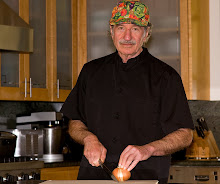
It's the Surgeon General clandestinely discovered smoking a cigarette.
Or the Dalai Lama having a temper tantrum.
That's how I feel when I make my beleaguered biweekly trip to North Berkeley's Andronico's meat counter to satisfy my 100- pound Alaskan Malamute's desire to taste real meat.
I approach these trips with much trepidation. Even though I love my dog Bella immensely, my ambivalence over what I'm doing causes me great anguish.
My wife and I are vegans and eschew all animal products.
Card-carrying PETA members, we have even discontinued wearing leather shoes and jackets. As a vegan chef for many years I have been educating and encouraging others to understand that adopting a vegan diet not only means good health, but it also means discovering new foods and exploring new tastes.
So now you can see why I would rather not have this issue thrust in my face every two weeks.
When I do summon the courage to purchase Bella's pound of ground turkey breast, I scan the meat counter to see if I recognize anyone.
It's equally important to see if anyone will recognize me. When I determine that the coast is clear, I meekly ask for my turkey breast. As a testament to my insecurity and anxiety, I always make it quite loud and clear that my purchase is for "my dog."
While impatiently waiting as the butcher weighs and packages it, I continuously make pronouncements that the turkey is for "my dog" just in case someone I might know should unexpectedly appear at the counter.
Fortunately I am prepared for just such an event, having at my ready several plausible explanations for my whereabouts.
Finally, package in hand, I make my way to the checkout counter, already considering which aisle appears to be the safest and most secure.
You are probably wondering why I choose to put myself though this stress on such a regular basis, and why I don't just feed Bella a vegan diet. My response is: dogs are omnivores, and though some breeds and individual dogs do quite well on a balanced vegan diet, Malamutes like my Bella are not one of those breeds. They have existed on the frozen tundra for centuries eating walrus and sundry entrails with great glee.
I suspect it's in Bella's DNA. Even though she is completely domesticated, Bella has a strong sense of prey and will patiently hunt every vermin, real or imaginary, during our daily walks at Tilden Park.
Which leaves me with my ongoing dilemma. It's gotten hard enough I just might adopt a technique reportedly used by Ruth Reichel. When she was the restaurant critic for the NY Times she was so well known to the restaurant establishment, she was forced to wear a disguise while visiting various eateries. She did this to obtain an authentic experience, rather than being treated as a VIP.
So if you ever see a guy in Andronico's who appears to be wearing a wig, well, you night want to ask him what his dog's name is.
Contra Costa Times July 11, 2009


